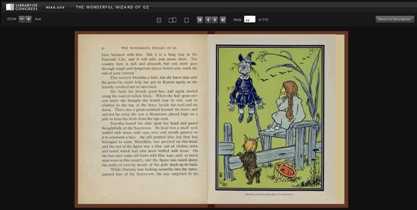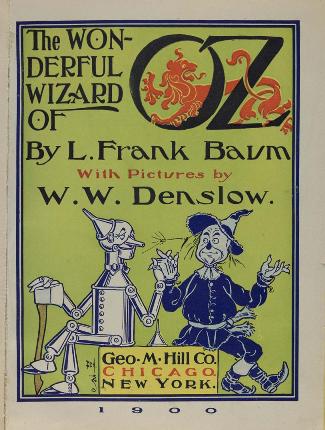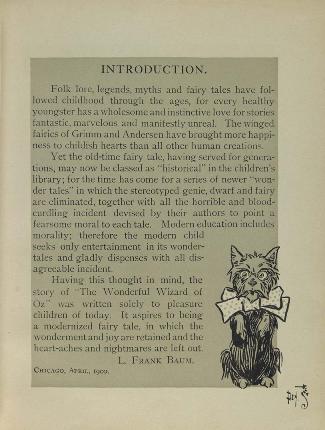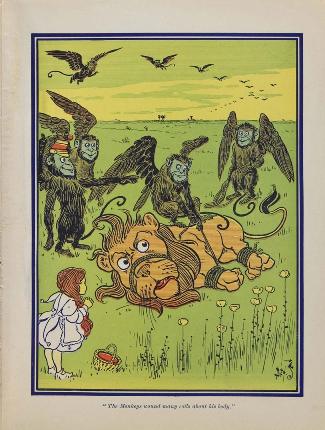Today would’ve been the 156th birthday of L. Frank Baum, the visionary author best known for his landmark children’s novel, The Wonderful Wizard of Oz, and everything else that spun off from that wild American fable about a young woman named Dorothy carried by a cyclone into the magical world of Oz. And, by “everything else,” I’m, of course, talking about more than just the 17 or so subsequent Oz books that were published both before and after Baum’s death. The Wonderful Wizard of Oz was a critical and commercial literary phenomenon, Baum adapted it himself into an acclaimed stage musical, The Wizard of Oz became one of the (if not THE) most famous movies of all time, Dorothy and her friends have become pop culture icons, there have been comic books, novels, musicals, video games, movies, mini-series, toys, clothing lines… all from that one little new-world fairy tale that L. Frank Baum and his illustrator W. W. Denslow published in 1900.
There’s a wonderful essay on the legacy and power of Baum’s Wonderful Wizard of Oz at Anita Silvey’s Children’s Book-a-Day Almanac today that can tell you far more about the Oz books that I can. I don’t own any of the Oz books, though I’ve come close to buying my daughter a copy on several occasions. Even though we haven’t read it yet, The Wizard of Oz is definitely on her radar – largely, I’ll admit, because of the movie. However, movie aside, I think that the story of Oz has evolved into one of those modern storytelling landmarks, the kind of story that just seeps into our collective unconscious without us really knowing how it got in there. My daughter has only watched about 60% of The Wizard of Oz movie – the witch and flying monkeys freak her out – but, even before that, she knew who Dorothy Gale was, she knew the Scarecrow, the Tin Man, the Lion, and she understood the “ignore the man behind the curtain!” reference. To me, when a story becomes that ubiquitous, it moves out of the realm of being a “really great kids’ book” and moves into the realm of folklore, myth, and legend.
And that might be exactly what Baum had hoped would happen. Let me explain…
If you want a really cool way to celebrate Baum‘s birthday today, I’d suggest going to the Library of Congress’ Read.gov. On this excellent site – which does a wonderful job promoting literary and the joy of reading – the Library of Congress has included some remarkable, high-quality digital scans of original editions of classic children’s titles, including L. Frank Baum and W. W. Denslow‘s The Wonderful Wizard of Oz. Thanks to the Library of Congress, you can page through the entire text of The Wonderful Wizard of Oz (or download a PDF of the entire book) and experience it in the same way that a reader would’ve experienced it in 1900. (Denslow’s illustrations are a particular highlight.) You can click here for some basic information on the edition and you can CLICK HERE to go right to the digital version of The Wonderful Wizard of Oz.

The Library of Congress has a fantastic digital version of "The Wizard of Oz" that you can download or read online for FREE
One of my favorite things about this edition of The Wizard of Oz is the original introduction that Baum wrote for the text. In his ambitious introduction – which is dripping with equal parts compassion and hubris – Baum states that he hopes that his story can be seen as a “modernized fairy tale” and makes an interesting argument for rejecting the “fearsome morals” of the earlier Brothers Grimm and Hans Christian Andersen fairy tales. Here’s what Baum wrote:
INTRODUCTION
Folk lore, legends, myths and fairy tales have followed childhood through the ages, for every healthy youngster has a wholesome and instinctive love for stories fantastic, marvelous and manifestly unreal. The winged fairies of Grimm and Andersen have brought more happiness to childish hearts than all other human creations.
Yet the old-time fairy tale, having served for generations, may now be classed as “historical” in the children’s library; for the time has come for a series of newer “wonder tales” in which the stereotyped genie, dwarf and fairy are eliminated, together with all the horrible and blood-curdling incident devised by their authors to point a fearsome moral to each tale. Modern education includes morality; therefore the modern child seeks only entertainment in its wonder-tales and gladly dispenses with all disagreeable incident.
Having this thought in mind, the story of “The Wonderful Wizard of Oz” was written solely to pleasure children of today. It aspires to being a modernized fairy tale, in which the wonderment and joy are retained and the heart-aches and nightmares are left out.
L. Frank Baum – Chicago, April, 1900
It’s almost more of a manifesto than an introduction, isn’t it? On one hand, it’s hard not to feel some empathy for an author who freely admits that he’s writing “solely” to make children happy. That’s a wonderfully earnest sentiment. On the other hand, it takes a pretty large ego to argue that we should toss out hundreds of years of fairy and folk tales – because Baum finds them heavy-handed and bloody – and replace them with new “wonder tales” that, apparently, don’t address morality or tragedy at all.
You have to admire Baum’s ambition, but, again, it’s strange to claim in one paragraph that the Brothers Grimm and Hans Christian Andersen “have brought more happiness to childish hearts than all other human creations” and then, in the very next paragraph, claim that those same fairy tales should now be relegated to the historical reference shelf of your local library. Fairy tales aren’t like laptops or video game systems. They don’t become obsolete every six months thanks to technological or sociological advances. People have been telling the story of “Cinderella” for three-hundred-plus years because something inherent in the folk tale connects with its reader on a very human and universal level – and not because we’ve all been sitting around waiting for a “Cinderella 2.0” to tell us her story better, stronger, faster, and without all the uncomfortable parts where bad things happen.
I’m not a huge fan of over-the-top moralizing in children’s books, but stories with moral lessons, particularly the ones that have endured for centuries, should never be dismissed outright. Some of them, as Baum himself noted, are among the most beloved stories in human history.
And, to his credit, Baum’s The Wonderful Wizard of Oz has also become one of humanity’s most treasured children’s stories. However, I find it funny that, when it was originally published, Baum intended his Wizard of Oz to usher in a new generation of fairy tales that would make the legends of past generations obsolete, but, in the end, The Wonderful Wizard of Oz didn’t replace the old folk tales, rather it joined them on the “classics” shelf at the library. Because, even though he tried to create a story without the characters, pitfalls, and “horrible and blood-curdling incidents” of the old stories, Baum instead created a story that tapped into the best of the storytelling tradition and has, so far, stood the test of time alongside the Grimms, Andersen, and all of the rest of the world’s fairy tale canon.
(And – as a quick personal sidenote – Baum wanted to ignore “horrible and blood-curdling incidents”? Are you kidding me? Then why does my daughter regard the Wicked Witch of the West and the Flying Monkeys as two of the scariest things she’s ever encountered? Just saying…)
If you get a chance, page through a copy of the Library of Congress‘ edition of The Wonderful Wizard of Oz today and take an interesting glimpse into the origins of an American legend.



{ 3 comments… read them below or add one }
I wonder if Baum wasn’t being impish/prankish/facetious/ironic in his introduction. I wonder if, perhaps, the introduction was actually meant to trick parents who would have been purchasing the books? It’s just too absurd. For it to be in earnest he would have had to be either extremely historically oblivious, or extremely self-oblivious, as regards the nature of what he himself had written.
I’d really like to find a historical account of what he himself thought about this intro.
Just so you know, you can get a reprint of the original. It’s William Morrow’s Books of Wonder series, and I got the first three because they were the original versions that I had read growing up. Here’s a link on Amazon for you: http://www.amazon.com/The-Wonderful-Wizard-Oz-Anniversary/dp/0060293233/ref=sr_1_8?ie=UTF8&qid=1338848849&sr=8-8
This was the series of books that got me reading avidly on my own. I love the original illustrations.
Oh fantastic! Thanks for letting me know!